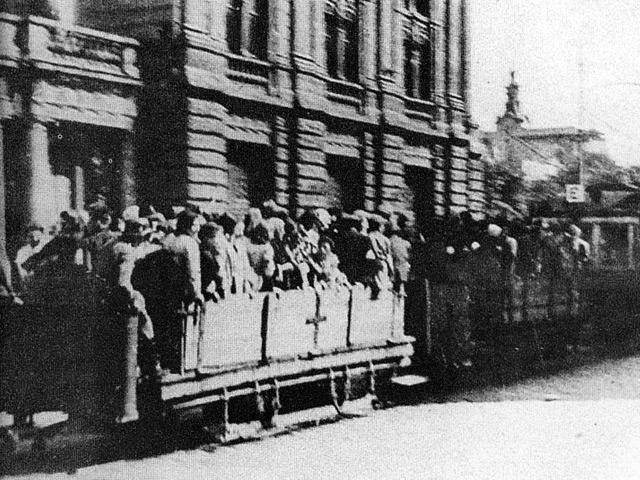The Jewish ghetto in Lviv has become the largest in the USSR and was second only to the Warsaw and Lodz ghettos. It was created according to the decree of the District of Galicia Governor Hans Frank of November 8, 1941 in the poorest district in Lviv. The ghetto occupied the territory of the Zamarstyniv and Klepariv sections, separated from the south by a railway embankment, from the east by Zamarstynivska street, from the west by Varshavska street and from the north by the bank of the Poltva river. Ukrainians and Poles who lived in this territory were to move to other districts of the city. From November 16 to December 14, 1941, the occupation authorities resettled more than 136 thousand Jews in the ghetto. Its territory was isolated from the city by a fence and barbed wire. The ghetto lacked water and food, medical supplies, housing; epidemics were spreading there. The employable Jewish population of the ghetto performed labor duties in the Janowska concentration camp, and the disabled were systematically destroyed. After the Wannsee conference decision, in the winter and spring of 1942, the Nazis began preparations for the mass extermination of Jews in the ghetto. The first deportation of Jews from the Lviv ghetto to the Bełżec death camp took place in March 1942. Its victims were 15 000 disabled Jews, mostly elderly people, women and children. During a large raid conducted in the ghetto at night from June 24 to 25, 1942, more than 2000 Jews were taken to the Janowska concentration camp, where about 120 people were left. Others were shot in the Piaski tract. In addition, 6 thousand prisoners were shot in the ghetto. In August 1942, more than 50 000 Lviv Jews were sent to the camp. At the beginning of September 1942, the territory of the ghetto was bounded by several streets and surrounded by a wall. At that time there were 65 thousand Jews.
At the beginning of November 1942, the Nazis again selected the ghetto prisoners for “professional suitability”. On November 18, 5 thousand people were arrested and deported to Bełżec. At that time, the ghetto was declared a “closed Jewish camp” and transferred to the direct disposal of the SS. In late November, more than 6 thousand Jews were transferred to a concentration camp and killed there. During the “December Campaign” of 1942, 7 thousand Jews were additionally exterminated. On January 5-7, 1943, another campaign was conducted, as a result of which 15-20 thousand Jews were shot in the Piaski tract. After that, it was announced that only those Jews who had the appropriate work permit could remain in the ghetto; and the ghetto was reorganized into the Judenlager Lemberg forced labor camp. The ghetto liquidation has been continuing until June 16, 1943. The last 4 thousand prisoners were transferred to the Janowska camp and subsequently exterminated in the Piaski tract. 3 thousand people committed suicide. After that, the Nazis declared Lviv freed from the Jews – “Judenfrei”. According to the Territory of Terror Museum, during the three years of German occupation, in the Lviv ghetto and the Janowska concentration camp, more than 250 thousand people died.
The Museum “Jewish Memory and Holocaust in Ukraine” exhibition contains unique exhibits. These are three miniature porcelain cups that have been a family heirloom for a long time. They were donated to the Museum by Mrs. Natalia Fedushchak (USA). She has got to know the story of these cups. They were part of a tea service, which a client, Jewish by birth, handed over to her grandfather, Oleksa Yavorskyi, a well-known lawyer, after the Nazi occupation of Poland began. This happened on the eve of the deportation of Jews from the Krakow ghetto to the Auschwitz death camp.
“One spring evening in 1941, in the German-occupied city of Krakow (Poland), at the door of the apartment where my grandfather lived with his family, there was a knock, - tells Natalia Fedushchak. My aunt opened and was surprised to see a strong and well-dressed Jew who had never visited them before. “I'm looking for Oleksa Yavorskyi”, said that gentleman. My grandfather was a lawyer and often received clients at home, so my aunt habitually escorted the man to his office. And there the man pulled a heavy wooden box from under his coat and put it on my grandfather’s table. Then he opened and showed six small cups: three - with the image of Napoleon and three - with the image of his wife Maria-Louise. “They are taking us tomorrow”, - the man said. “If we survive, I will find you and take them back. If not, then I entrust them to you for safekeeping”. He said the service was his wedding present. The man never returned for his box.”
The Museum’s library also offers to get acquainted with the following publications dedicated to the Lviv ghetto:
- Kovba Zh. Lviv Ghetto Diary. Memoirs of Rabbi David Kahane. Ed. 2. Kyiv: DUH I LITERA, 2009. 276 p.
- Honigsman J. The Catastrophe of Lviv Jewry. Lviv, 1993. 58 p.
Dilfuza Hlushchenko

